A Summertime Ice Mine
Air Date: Week of July 18, 2014
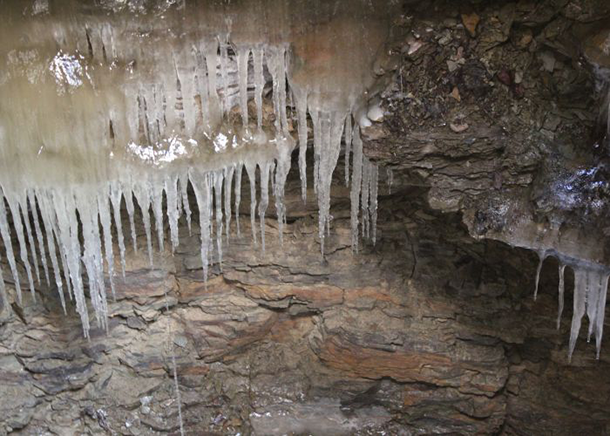
Ice only forms during summer within Pennsylvania’s Coudersport Ice Mine. The ice looks like long elephant tucks hanging from the rocks. (Photo: Kara Holsopple)
Tucked away in Pennsylvania’s Appalachian Mountains lies an unusual cave. It’s the Coudersport Ice Mine, a roadside attraction closed 25 years ago that only recently reopened. Kara Holsopple from the Allegheny Front reports that this strange cave only forms ice in the summer.
Transcript
CURWOOD: At this time of year, many people head for the shore or the mountains to escape the city heat, and there’s one special spot in the Appalachians of Pennsylvania that’s still as cold as winter. The Coudersport Ice Mine in Potter County was a roadside tourist attraction for many years, but it closed down a quarter of a century ago. This natural wonder is open again, and Kara Holsopple of the public radio program, the Allegheny Front, takes us on a tour.
HOLSOPPLE: On Ice Mountain, part of the Appalachians in North Central Pennsylvania, at the top of Ice Mine Road, $4 will get you one admission into something a little different from the campsites and hiking trails around here.
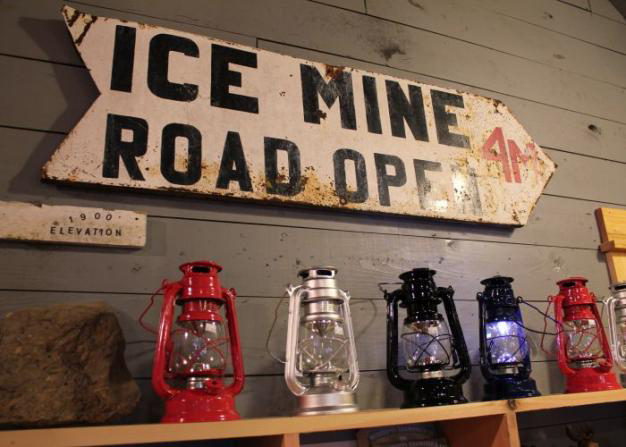
The Coudersport Ice Mine was found by a silver prospector in 1894. The mine had been closed for some time, but was recently purchased by the Buchsens, restored and reopened to the public. (Photo: Kara Holsopple)
[CUSTOMERS IN GIFT SHOP]
HOLSOPPLE: One, please.
[CASH REGISTER]
HOLSOPPLE: A lot of folklore is attached to the Coudersport Ice Mine, including the rumor it’s man-made. That’s because some people, even people who live here, can’t believe that ice inside the ice mine only forms here during the summertime.
But 19-year-old Jeff McManus is a believer. He’s giving tours today.
[MCMANUS OUTDOORS]
MCMANUS: My dad was a tour guide in the ’70s and my grandma worked in the gift shop in the ’50s.
HOLSOPPLE: The site has been closed longer than he’s been alive, but it’s just reopened under new management. He opens the lock on a weathered door with a shiny new key.
[KEYS IN LOCK AND DOOR OPENING]
PATTY STAFFA: Whoa, it is cold. It’s freezing.
KEVIN STAFFA: This is what I remember last time being here.
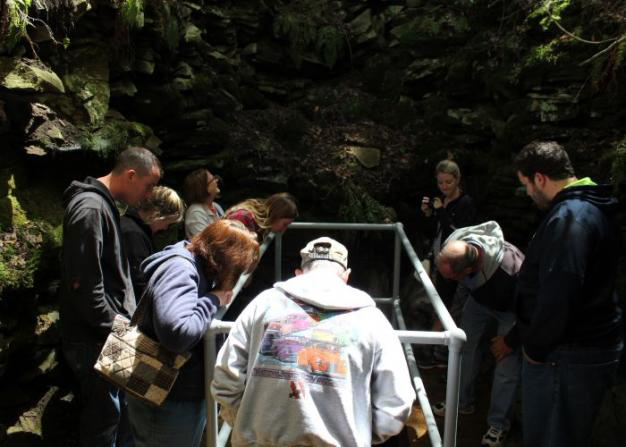
A few people at a time can peer over the frosty metal rail into the ice mine. (Photo: Kara Holsopple)
HOLSOPPLE: Kevin and Patty Staffa are visiting with family from New Jersey. They were here once before it closed. It’s about 32 degrees behind the door, like walking into a refrigerator.
A small group of people at a time can stand around a wooden platform and lean over the metal railing, which surrounds the opening into the earth. It’s really just an eight by ten feet pit, a cave a few dozen feet deep. Below there are icicles like elephant tusks clinging to the sides of the mine.
MCMANUS: There’s about 18 inches of ice right now on the bottom.
HOLSOPPLE: All around the opening are layers of rocks, covered in moss and dripping with water. It’s a small dungeon-like room that’s open at the top. Looking up, you see clouds and old hemlock trees swaying in the breeze.
MCMANUS: They think that during the winter the air is pushed into the mountain, because the rocks are layered like this through the whole mountain, and then in the summer, the air comes out, mixes with the humidity and the heat, forming the ice.
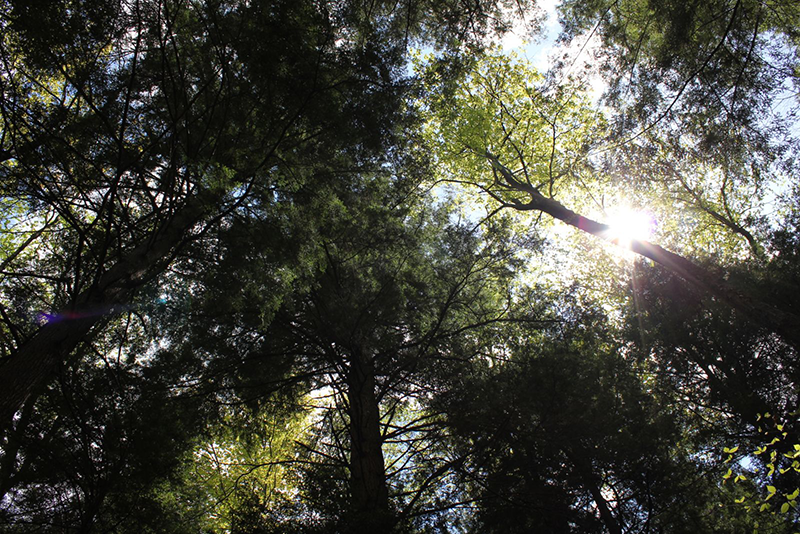
Looking up from inside the ice mine, you see clouds and old hemlock trees swaying in the breeze. (Photo: Allegheny Front)
HOLSOPPLE: You can feel it if you put your hand up to the tower of rocks.
PATTY STAFFA: Right here, it’s cold, very cold. Right there.
KEVIN STAFFA: This is really cool.
[WATER DRIPPING]
MCMANUS: The bigger icicles are under there. You can kind of see them.
HOLSOPPLE: The hotter it is outside, the more ice forms.
MCMANUS: A few weeks ago there was ice around the whole entire thing, touching the bottom. But because it’s been colder weather, and we had all this rain, it’s broken down inside.
[WATER DRIPPING]
HOLSOPPLE: The mine was found by a silver prospector in 1894. It was used to store meat, and the ice was harvested. Then it was turned into a tourist attraction in the early 1900s. This ice mine is one of many so-called “cold spots” from southern New York to West Virginia in these mountains.
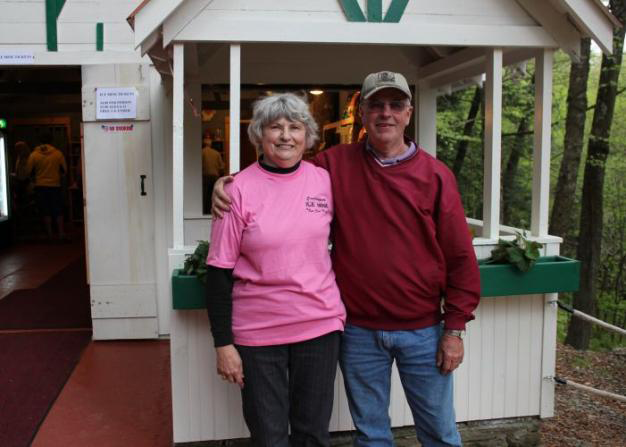
Diana and Gary Buchsen recently purchased, restored and reopened the ice mine to the public. (Photo: Kara Holsopple)
Outside the mine on the patio, Diana Buchsen is greeting guests.
BUCHSEN: Hello! Go right on in!
HOLSOPPLE: Buchsen and her husband Gary own a nearby inn, and bought the old ice mine about a year ago. Buchsen says the ice mine is never going to be Niagara Falls or an amusement park. She wants visitors to experience something else here.
BUCHSEN: I just hope they take that quietness, and peacefulness, and stress-free lifestyle that we’re hoping to promote up here.
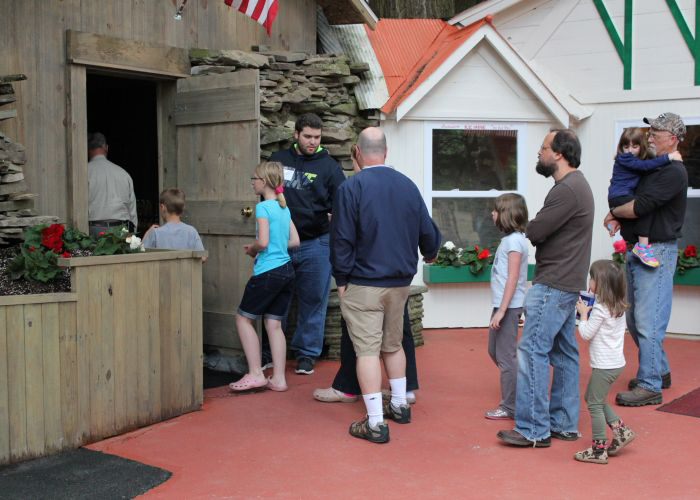
Visitors line up to enter the Coudersport Ice Mine. (Photo: Allegheny Front)
HOLSOPPLE: So far hundreds have come to take a peek at the ice and sign the guest book from as far away as Germany. Buchsen’s cousin Chris Herzig didn’t travel as far—she’s from right here in Coudersport, and she has a new idea to promote the mine.
HERZIG: Those of us that are of a certain age that have hot flashes, I think there should be a special ticket that you can go in and out as many times as needed [LAUGHS] for medicinal purposes.
CURWOOD: Kara Holsopple of the Allegheny Front prepared this audio postcard. There’s more at our website, LOE.org.
Links
Living on Earth wants to hear from you!
Living on Earth
62 Calef Highway, Suite 212
Lee, NH 03861
Telephone: 617-287-4121
E-mail: comments@loe.org
Newsletter [Click here]
Donate to Living on Earth!
Living on Earth is an independent media program and relies entirely on contributions from listeners and institutions supporting public service. Please donate now to preserve an independent environmental voice.
NewsletterLiving on Earth offers a weekly delivery of the show's rundown to your mailbox. Sign up for our newsletter today!
 Sailors For The Sea: Be the change you want to sea.
Sailors For The Sea: Be the change you want to sea.
 The Grantham Foundation for the Protection of the Environment: Committed to protecting and improving the health of the global environment.
The Grantham Foundation for the Protection of the Environment: Committed to protecting and improving the health of the global environment.
 Contribute to Living on Earth and receive, as our gift to you, an archival print of one of Mark Seth Lender's extraordinary wildlife photographs. Follow the link to see Mark's current collection of photographs.
Contribute to Living on Earth and receive, as our gift to you, an archival print of one of Mark Seth Lender's extraordinary wildlife photographs. Follow the link to see Mark's current collection of photographs.
 Buy a signed copy of Mark Seth Lender's book Smeagull the Seagull & support Living on Earth
Buy a signed copy of Mark Seth Lender's book Smeagull the Seagull & support Living on Earth

